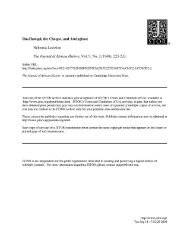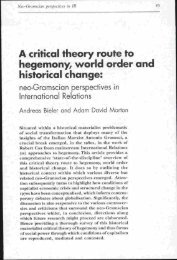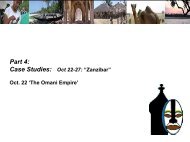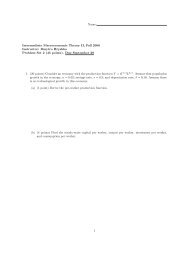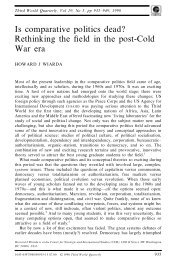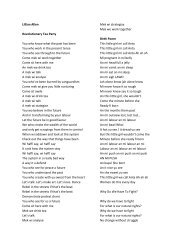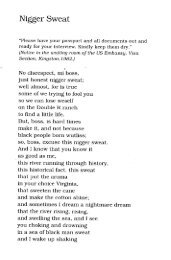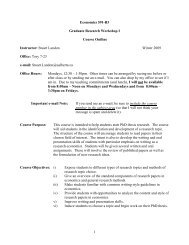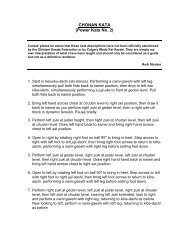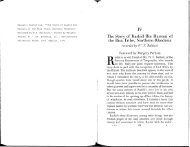personal memories revolutionary states and indian ocean migrations
personal memories revolutionary states and indian ocean migrations
personal memories revolutionary states and indian ocean migrations
Create successful ePaper yourself
Turn your PDF publications into a flip-book with our unique Google optimized e-Paper software.
adopted the modernist discursive<br />
strategy vis-à-vis Jaffa of Jewish<br />
cleanliness versus native urban squalor,<br />
even though many of them were more<br />
cognizant of the presence of (<strong>and</strong> the<br />
need to cooperate with) Palestinians in<br />
Palestine than agriculturalist Zionists.<br />
Chapter Four analyses the<br />
relations between Arabs, both Muslims<br />
<strong>and</strong> Christians, <strong>and</strong> Jews through everintensifying<br />
labor disputes during the<br />
M<strong>and</strong>ate period <strong>and</strong> ends, somewhat<br />
achronologically, with the fateful May<br />
1921 clashes between a group of<br />
rampant Jewish Marxists <strong>and</strong> Jaffan<br />
residents. The deaths of forty Jews <strong>and</strong><br />
the looted shops in the mixed, well-todo<br />
neighborhoods of Manshiyya, Neve<br />
Shalom <strong>and</strong> `Ajami led to the<br />
administrative segregation of the two<br />
towns. Manshiyya in particular became<br />
both the connecting piece <strong>and</strong> the<br />
Green Line along which, sporadically,<br />
violence flared up between Palestinians<br />
<strong>and</strong> Zionists. This northern most part<br />
of Jaffa had already been identified as a<br />
strategic urban location by a late<br />
Ottoman governor. The Hassan Bey<br />
Waqf/Mosque, in the words of Jaffa’s<br />
last mayor, Yusuf Heykal, was an<br />
effective bulwark against Tel Aviv’s<br />
southward expansion. (73-4)<br />
These early chapters are based<br />
on a wide variety of archival sources<br />
including Israeli state, university, <strong>and</strong><br />
Tel Aviv municipal archives; Hebrew<br />
<strong>and</strong> Arabic newspapers; Jaffa shari`a<br />
court records; <strong>and</strong> memoirs as well as<br />
French <strong>and</strong> British consular<br />
correspondence (not, however, as<br />
suggested, Ottoman archives). In<br />
Chapter Five LeVine returns to the<br />
foundational myth of Tel Aviv built on<br />
s<strong>and</strong>. He does so in a systematic<br />
reading of literary sources on Jaffa <strong>and</strong><br />
Tel Aviv which brings out the emotional<br />
attachment to the capitals of the two<br />
competing nationalist movements. Far<br />
from a level playing field, Arabic<br />
literature about Jaffa – newspaper<br />
articles, cartoons <strong>and</strong> poetry – is about<br />
disappearance <strong>and</strong> loss, while Tel Aviv,<br />
http://web.mit.edu/cis/www/mitejmes/<br />
97<br />
“the White City,” is about the triumph<br />
of Jewish culture over Palestinian<br />
nature.<br />
Chapter Six is very much the<br />
centerpiece of the book <strong>and</strong> deals with<br />
the complex intersections between<br />
urban planning, architectural aesthetics,<br />
<strong>and</strong> national identity. Early Zionist<br />
planning discourse was ideologically<br />
modernist <strong>and</strong> drew self-perception<br />
from its difference to Jaffa’s “traditional”<br />
urban fabric even as Jewish architects<br />
used local designs <strong>and</strong> construction<br />
techniques, <strong>and</strong> even though Jaffan<br />
patricians themselves built modernist<br />
residences at the same time. LeVine<br />
identifies two more “cracks” in the<br />
Zionist edifice of architectural ideology:<br />
Tel Aviv emerged not just as the<br />
negation of Jaffa but also its thriving<br />
Jewish neighborhoods, <strong>and</strong> – in the<br />
words of Arthur Ruppin – it would<br />
“present the most important step<br />
toward the economic conquest of Jaffa<br />
by the Jews.” (p. 157). Long before<br />
Jaffa was forcibly annexed by the Tel<br />
Aviv municipality in 1948, then, the two<br />
cities constituted a single, but dual city<br />
tied together by colonial appropriations.<br />
Chapter Seven is the most<br />
significant contribution of this book to<br />
the debate of Zionism as colonialism,<br />
perhaps because it leaves the<br />
representational <strong>and</strong> discursive level to<br />
examine the impact of Zionism’s<br />
ideological commitment to conquer<br />
Jaffa on Palestinian l<strong>and</strong> tenure.<br />
Conventional wisdom in Israel is that<br />
Palestinian l<strong>and</strong> was either purchased<br />
from absentee l<strong>and</strong>lords <strong>and</strong> peasants<br />
above the market price, or it was rural<br />
wastel<strong>and</strong> inherited from Ottoman<br />
times. LeVine shows that invidious<br />
manipulations of the existing l<strong>and</strong> laws<br />
by the British M<strong>and</strong>ate authority<br />
facilitated the urban expansion of Tel<br />
Aviv long before Israeli “transfer-asethnic-cleansing”<br />
during <strong>and</strong> after the<br />
1948 War. 1 Ottoman l<strong>and</strong> definitions<br />
1 For a recent reflection on Israeli transferas-ethnic-cleansing<br />
policies, see Robert



